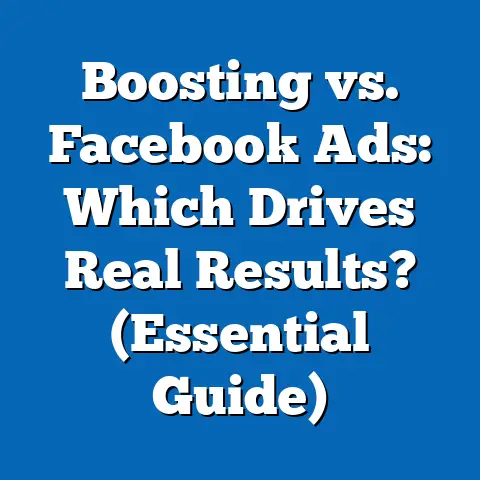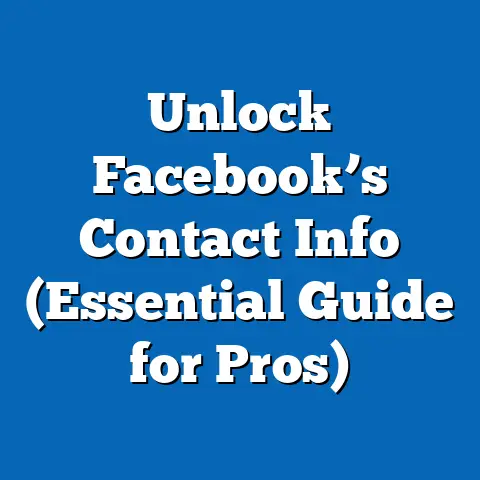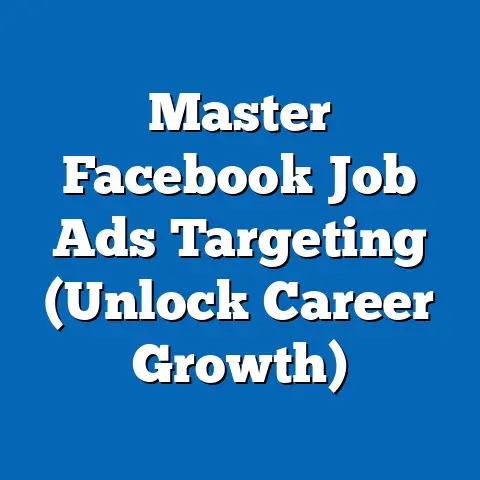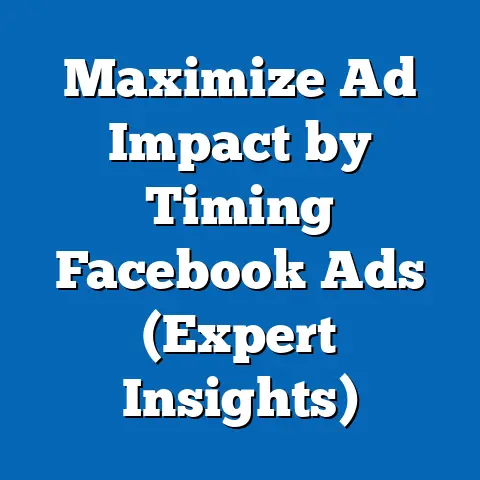Master Facebook Ad Text Editing (Pro Insights Revealed)
Master Facebook Ad Text Editing: Pro Insights Revealed
How often do you scroll through your Facebook feed, pausing on a compelling ad that speaks directly to your interests and desires? I know I do! And that’s because behind every attention-grabbing ad, there’s a carefully crafted message designed to resonate with the audience and drive conversions. In the digital marketing landscape, effective ad text is essential. It’s the first (and sometimes only) thing potential customers see, so it needs to be captivating, informative, and persuasive.
Facebook ad text editing is more than just writing catchy phrases; it’s an art and a science. It involves understanding your audience, knowing what motivates them, and then using that knowledge to craft messages that not only grab their attention but also compel them to take action.
In this article, I’m going to pull back the curtain and share some professional insights and strategies for mastering the art of Facebook ad text editing. I’ll walk you through the basics, delve into the psychology behind effective copywriting, share actionable tips, highlight common mistakes to avoid, and show you how to use analytics to optimize your ad text for maximum impact. Let’s get started!
Understanding the Basics of Facebook Ad Text
Before we get into the nitty-gritty, let’s cover the fundamentals. What exactly are the key components of Facebook ad text?
- Headline: This is the first thing people see, and it’s your chance to grab their attention. It needs to be short, punchy, and relevant.
- Primary Text: This is the main body of your ad copy. It’s where you get to explain your offer, highlight the benefits, and connect with your audience.
- Call to Action (CTA): This is what you want people to do after they see your ad. It could be “Shop Now,” “Learn More,” “Sign Up,” or any other action that aligns with your campaign goals.
Each of these elements has character limitations, which can feel incredibly restrictive at times. The headline is usually the shortest, forcing you to be concise and creative. The primary text offers a bit more room, but you still need to be mindful of length, especially on mobile devices where longer text can get truncated.
My Experience: I remember one campaign where I was promoting a new line of eco-friendly cleaning products. I had this amazing, detailed description of all the ingredients, the sustainable packaging, and the positive impact on the environment. It was beautiful! But then I realized it was way too long for the primary text. I had to chop it down, focusing on the core benefit: “Clean your home, save the planet!” It was tough, but it worked. Sometimes less is more.
Facebook’s algorithms and audience targeting play a crucial role in shaping ad text effectiveness. The algorithm determines who sees your ad based on various factors, including their interests, demographics, and behaviors. Your ad text needs to be relevant to these factors to ensure that it resonates with the target audience.
For example, if you’re targeting young adults interested in fitness, your ad text should speak to their desire for a healthy lifestyle, using language and imagery that appeals to them. If you’re targeting older adults interested in travel, your ad text should focus on the benefits of exploring new destinations and creating lasting memories.
Let’s look at some examples of successful ad text and analyze what makes them effective:
-
Example 1: Shopify
- Headline: Start Your Free Trial Today
- Primary Text: Build your online store with Shopify. No coding required. Get a 14-day free trial and start selling today.
- CTA: Start Free Trial
- Why it works: The headline is clear and direct, offering a tangible benefit (a free trial). The primary text highlights the ease of use (no coding required) and reinforces the offer. The CTA is action-oriented and aligns with the offer.
-
Example 2: Dollar Shave Club
- Headline: Get Amazing Razors Delivered to Your Door
- Primary Text: Stop overpaying for razors. Get high-quality blades delivered to your door for just a few bucks a month.
- CTA: Get Started
- Why it works: The headline addresses a common pain point (overpaying for razors). The primary text offers a compelling solution (high-quality blades at a low price). The CTA is simple and encourages immediate action.
-
Example 3: Skillshare
- Headline: Unlock Your Creativity with Online Classes
- Primary Text: Learn new skills from expert instructors. Thousands of classes in design, photography, business, and more. Start your free trial today.
- CTA: Start Free Trial
- Why it works: The headline appeals to a desire for self-improvement and creativity. The primary text highlights the breadth of course offerings and the expertise of the instructors. The CTA is clear and aligns with the offer.
Example 1: Shopify
- Headline: Start Your Free Trial Today
- Primary Text: Build your online store with Shopify. No coding required. Get a 14-day free trial and start selling today.
- CTA: Start Free Trial
- Why it works: The headline is clear and direct, offering a tangible benefit (a free trial). The primary text highlights the ease of use (no coding required) and reinforces the offer. The CTA is action-oriented and aligns with the offer.
Example 2: Dollar Shave Club
- Headline: Get Amazing Razors Delivered to Your Door
- Primary Text: Stop overpaying for razors. Get high-quality blades delivered to your door for just a few bucks a month.
- CTA: Get Started
- Why it works: The headline addresses a common pain point (overpaying for razors). The primary text offers a compelling solution (high-quality blades at a low price). The CTA is simple and encourages immediate action.
Example 3: Skillshare
- Headline: Unlock Your Creativity with Online Classes
- Primary Text: Learn new skills from expert instructors. Thousands of classes in design, photography, business, and more. Start your free trial today.
- CTA: Start Free Trial
- Why it works: The headline appeals to a desire for self-improvement and creativity. The primary text highlights the breadth of course offerings and the expertise of the instructors. The CTA is clear and aligns with the offer.
Takeaway: Understanding the basics of Facebook ad text is essential for creating effective ads. By crafting clear, concise, and relevant messages, you can grab your audience’s attention and drive conversions.
The Psychology of Ad Copywriting
Ad copywriting isn’t just about writing pretty words; it’s about understanding the human mind and tapping into the psychological triggers that motivate people to take action.
- Emotional Triggers: People make decisions based on emotions, not just logic. Your ad text should appeal to their emotions, whether it’s happiness, fear, excitement, or nostalgia.
- Social Proof: People are more likely to take action if they see that others are doing it too. Include testimonials, reviews, or social media mentions in your ad text to build trust and credibility.
- Urgency: Creating a sense of urgency can compel people to act quickly. Use phrases like “Limited Time Offer,” “While Supplies Last,” or “Don’t Miss Out” to encourage immediate action.
My Experience: I once ran a campaign for a local restaurant, and we tried two different approaches. One ad focused on the delicious food and the cozy atmosphere. The other ad focused on a limited-time discount and the chance to win a free meal. Guess which one performed better? The one with the limited-time offer! People were more motivated by the fear of missing out than by the promise of a good meal.
Understanding your audience’s motivations is crucial for creating effective ad text. What are their pain points? What are their desires? What are their goals? The more you know about your audience, the better you can tailor your ad text to resonate with them.
Storytelling is a powerful tool for engaging the audience on a deeper level. Instead of just listing the features of your product or service, tell a story about how it can improve their lives. Share a customer success story, paint a picture of the benefits, or create a narrative that connects with their emotions.
Takeaway: By understanding the psychology behind ad copywriting, you can create messages that not only grab attention but also compel people to take action. Tap into emotional triggers, use social proof, create a sense of urgency, and tell compelling stories to connect with your audience on a deeper level.
Here’s a step-by-step guide for writing effective ad copy:- Know Your Audience: Before you start writing, take the time to understand your target audience. What are their demographics, interests, and behaviors? What are their pain points and desires? The more you know about your audience, the better you can tailor your ad text to resonate with them.
- Define Your Goal: What do you want people to do after they see your ad? Do you want them to visit your website, sign up for your email list, make a purchase, or download your app? Define your goal clearly before you start writing, and make sure your ad text aligns with that goal.
- Craft a Compelling Headline: Your headline is the first thing people see, so it needs to grab their attention. Use strong, action-oriented language, highlight a key benefit, or ask a question that piques their curiosity.
- Write Engaging Body Copy: Your body copy should explain your offer, highlight the benefits, and connect with your audience. Use clear and concise language, avoid jargon, and maintain a consistent brand voice.
- Include a Clear Call to Action: Your call to action should tell people exactly what you want them to do. Use action-oriented language and make it easy for them to take the desired action.
- Use Visuals: Pair your ad text with high-quality images or videos that capture attention and convey your message effectively.
- A/B Test Your Ad Text: A/B testing involves creating multiple versions of your ad text and testing them against each other to see which one performs best. Test different headlines, body copy, and calls to action to identify what resonates best with your audience.
- Optimize for Mobile: Most people access Facebook on their mobile devices, so it’s essential to optimize your ad text for mobile viewing. Keep your headlines and body copy short and concise, and use clear and easy-to-read fonts.
My Experience: A/B testing has been a game-changer for me. I used to rely on my gut feeling when writing ad text, but now I let the data guide me. I once ran an A/B test for a client who was selling online courses. We tested two different headlines: “Learn New Skills” and “Transform Your Career.” The “Transform Your Career” headline performed significantly better, resulting in a higher click-through rate and more conversions. It just goes to show that even small changes can make a big difference.
When crafting headlines, try these techniques:
- Use numbers: “5 Ways to…” or “10 Tips for…” Numbers grab attention and promise specific, actionable information.
- Ask a question: “Are you struggling with…?” Questions engage the reader and make them think about their own situation.
- Make a bold statement: “The secret to…” or “The ultimate guide to…” Bold statements create curiosity and intrigue.
For body copy, focus on these points:
- Highlight the benefits: Don’t just list the features of your product or service; explain how it will benefit the customer.
- Speak to their pain points: Show that you understand their challenges and offer a solution.
- Use social proof: Include testimonials, reviews, or social media mentions to build trust and credibility.
When it comes to calls to action, make sure they are:
- Clear and concise: Tell people exactly what you want them to do.
- Action-oriented: Use strong verbs like “Shop,” “Learn,” “Sign Up,” or “Download.”
- Relevant: Make sure the call to action aligns with your offer and your campaign goals.
Takeaway: Crafting compelling Facebook ad text is an art and a science. By knowing your audience, defining your goal, writing engaging copy, using visuals, A/B testing, and optimizing for mobile, you can create ads that grab attention, connect with your audience, and drive conversions.
Common Mistakes to Avoid in Facebook Ad Text Editing
Even the most experienced marketers make mistakes when editing Facebook ad text. Here are some common pitfalls to avoid:
- Overloading Ads with Information: Trying to cram too much information into your ad text can overwhelm your audience and dilute your message. Focus on the most important points and keep your ad text concise and easy to read.
- Failing to Align with Target Audience Interests: If your ad text doesn’t resonate with your target audience, it’s unlikely to generate results. Make sure your ad text is relevant to their interests, demographics, and behaviors.
- Neglecting Mobile Optimization: As I mentioned earlier, most people access Facebook on their mobile devices, so it’s essential to optimize your ad text for mobile viewing. Long headlines and body copy can get truncated on mobile, so keep them short and sweet.
- Using Jargon or Technical Terms: Avoid using jargon or technical terms that your audience may not understand. Use clear and simple language that everyone can easily grasp.
- Making Grammatical Errors: Grammatical errors can make your ad look unprofessional and damage your credibility. Proofread your ad text carefully before publishing it.
- Ignoring the Visuals: Your ad text should complement your visuals, not compete with them. Make sure your visuals are high-quality, relevant, and attention-grabbing.
My Experience: I once made the mistake of using too much jargon in an ad for a new software product. I was so excited about all the technical features that I forgot to explain them in a way that non-technical people could understand. The ad performed poorly, and I realized that I had completely missed the mark. I went back and rewrote the ad text using simple, everyday language, and the results improved dramatically.
Let’s look at some examples of poorly executed ads and analyze what went wrong:
- Example 1: An ad for a local gym with a long, rambling description of all the equipment and classes, without highlighting any specific benefits or offering a clear call to action.
- What went wrong: The ad was too long and unfocused, failing to grab attention or provide a compelling reason to join the gym.
- Example 2: An ad for a new mobile app with a headline that used technical jargon that most people wouldn’t understand.
- What went wrong: The ad failed to connect with the target audience because it used language that was too complex and unfamiliar.
- Example 3: An ad for a clothing store with a blurry, low-quality image that didn’t showcase the clothing in an appealing way.
- What went wrong: The ad failed to capture attention because the visuals were poor and didn’t entice people to click.
- What went wrong: The ad was too long and unfocused, failing to grab attention or provide a compelling reason to join the gym.
- What went wrong: The ad failed to connect with the target audience because it used language that was too complex and unfamiliar.
- What went wrong: The ad failed to capture attention because the visuals were poor and didn’t entice people to click.
Takeaway: Avoiding common mistakes in Facebook ad text editing can significantly improve your ad performance. Keep your ad text concise, relevant, and easy to read, optimize for mobile, avoid jargon, proofread carefully, and use high-quality visuals.
The Role of Analytics in Ad Text Optimization
Analytics are your best friend when it comes to optimizing your ad text. By tracking key metrics, you can see what’s working and what’s not, and then make adjustments to improve your ad performance.
Facebook Insights is a powerful tool that provides a wealth of data about your ad campaigns. Here are some key metrics to track:
- Click-Through Rate (CTR): This is the percentage of people who saw your ad and clicked on it. A high CTR indicates that your ad text is compelling and relevant.
- Engagement Rate: This is the percentage of people who interacted with your ad, such as liking, commenting, or sharing it. A high engagement rate indicates that your ad text is resonating with your audience.
- Conversion Rate: This is the percentage of people who took the desired action after clicking on your ad, such as making a purchase or signing up for your email list. A high conversion rate indicates that your ad text is effectively driving results.
- Cost Per Click (CPC): This is the amount you pay each time someone clicks on your ad. A low CPC indicates that your ad text is efficient and cost-effective.
- Cost Per Acquisition (CPA): This is the amount you pay each time someone takes the desired action after clicking on your ad. A low CPA indicates that your ad text is effectively driving conversions at a reasonable cost.
My Experience: I once ran a campaign for a client who was selling e-books. We were getting a decent click-through rate, but the conversion rate was low. I dug into the analytics and realized that people were clicking on the ad, but they weren’t actually buying the e-book. I looked at the ad text and realized that it wasn’t clearly explaining the benefits of the e-book. I rewrote the ad text to highlight the key takeaways and the value that people would get from reading the e-book, and the conversion rate improved significantly.
Iterating and improving your ad text based on data findings is crucial for long-term success. Don’t be afraid to experiment with different headlines, body copy, and calls to action to see what works best. Continuously monitor your analytics and make adjustments as needed.
Here are some tips for using analytics to optimize your ad text:
- Track Your Key Metrics: Regularly monitor your CTR, engagement rate, conversion rate, CPC, and CPA to see how your ads are performing.
- Identify Areas for Improvement: Look for areas where your ads are underperforming. Is your CTR low? Is your engagement rate low? Is your conversion rate low?
- Experiment with Different Ad Text: Try different headlines, body copy, and calls to action to see what resonates best with your audience.
- Monitor Your Results: Track your metrics after making changes to see if your ad performance has improved.
- Repeat the Process: Continuously monitor your analytics and make adjustments as needed to optimize your ad text for maximum impact.
Takeaway: Analytics are essential for optimizing your Facebook ad text. By tracking key metrics, identifying areas for improvement, experimenting with different ad text, and monitoring your results, you can continuously improve your ad performance and drive better results.
Conclusion
Mastering Facebook ad text editing is a crucial skill for any marketer looking to succeed in the digital landscape. It’s not just about creativity; it’s about understanding your audience, knowing what motivates them, and then using that knowledge to craft messages that not only grab their attention but also compel them to take action.
I’ve shared a lot of tips and insights in this article, but the most important thing is to remember that effective ad text is a combination of art and science. It requires creativity, empathy, and a willingness to experiment and learn.
By understanding the basics of Facebook ad text, delving into the psychology behind effective copywriting, following my tips for crafting compelling ad text, avoiding common mistakes, and leveraging analytics for optimization, you can enhance your own Facebook ad campaigns and achieve greater success in your marketing efforts.
Now, go forth and create some amazing ad text!
Call to Action:
I’d love to hear about your experiences with Facebook ad text editing. Share your tips, challenges, and success stories in the comments section below or on social media platforms. Let’s learn from each other and build a community of skilled ad copywriters!





